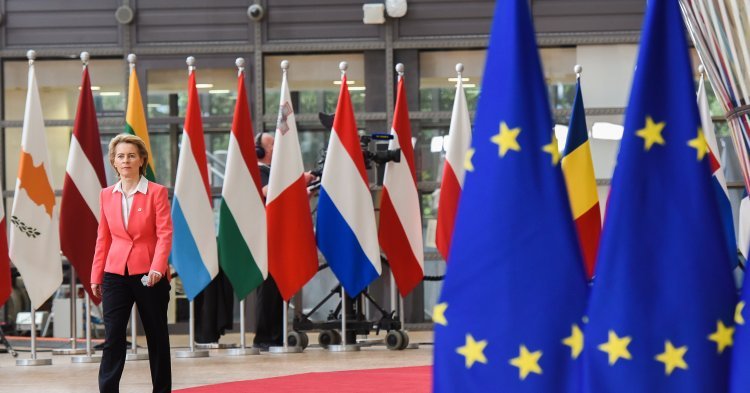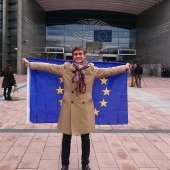“Deal!” The reaction from the European Council President Charles Michel may have been succinct, but his relief was huge. After the longest European Council meeting since the 2000 Nice Summit that led up to the eponymous treaty, the heads of state and government reached a compromise at 5:40am on the “Next Generation EU” recovery plan and the multiannual financial framework for 2021–2027. These two tools are intended to constitute an effective response to the economic consequences brought on by the coronavirus crisis that has been raging on since the start of the year.
“These were, of course, difficult negotiations in very difficult times for all Europeans. [...] This is a good deal. This is a strong deal. And most importantly, this is the right deal for Europe, right now”, the former Belgian Prime Minister Michel said at the end of the marathon.
“We negotiated for four long days and nights – more than 90 hours – but it was worth it. This agreement is a signal that Europe is capable of taking action”, added the European Commission President Ursula von der Leyen, who had on 27 May proposed the Next Generation EU fund and an increased budget for 2021–2027. The main national leaders were also pleased with the agreement. “A historic day for Europe!”, exclaimed the French President Emmanuel Macron, while the German Chancellor Angela Merkel added soberly that “it was not easy, but what matters to me is that we worked it out and that we all are convinced that we can all make something of the result”.
Likewise, there was satisfaction among the “frugal” or “stingy” club (the Netherlands, Austria, Denmark and Sweden, joined by Finland over the weekend). “The result of the negotiations is positive and takes Dutch interests into account”, the Dutch Prime Minister Mark Rutte jubilated. Sebastian Kurz, the Austrian premier, even shared a photo of the four “frugal” leaders smiling, highlighting the “good results” of the meeting.
Despite the relief of reaching an agreement after four days of negotiation, there remain several concerns and dark spots. Generally, the extremely tense atmosphere at this European Council meeting in itself should ring alarm bells about the very nature of the relationship and solidarity between European partners. Here is a (nonexhaustive) list of lessons from these abnormal negotiations.
1. By breaking two taboos, Europe showed that it can still progress
On an optimistic note, we should say that the main lesson from this institutional marathon in Brussels is that the EU managed to agree on an unprecedentedly ambitious recovery plan as its response to the crisis that has been no less extraordinary. Eurostat has projected an 8.7% contraction in the European economy – for comparison, the recession in 2009 only saw a drop of 1.8%.
Last weekend was the latest development in what has been a rather effective European response to the coronavirus crisis, especially when compared to the fumbling seen during the sovereign debt crisis of the previous decade. After the strong tensions already seen during the March European Council, the Eurogroup elaborated a rescue plan worth €540 billion at the start of April. The European Central Bank demonstrated remarkable speed in announcing its securities purchase programme worth €1,350 billion in total.
“Next Generation EU” will consist of €750 billion that the Commission will borrow from the financial markets (the first time the Commission has borrowed such a large amount), and it will be appended to the 2021–2027 European budget of €1,075 billion (which is €25 billion less than in the Commission proposal). The funds raised will mainly be used under the “Recovery and Resilience Facility” worth €672.5 billion between 2021 and 2024, with a phased payback lasting until the end of the year 2058.
Even if the European Parliament must still have its say, the deal shows that, with its back against the wall, the EU can still find the necessary resources for its survival. Besides, the partial mutualisation of debts at the European level and the redistribution of some of the money as direct grants are two major innovations that the crisis has made possible.
2. Future-oriented policies sacrificed to fund rebates for the pickpennies
Now that we’ve covered the good news, it’s necessary to say that several flaws stain the conclusions of the European Council meeting. Even if the principle of budgetary transfers has now definitively turned into reality, the subventions going to the hardest-hit regions are only 390 billion euros, compared to the €500 billion suggested in the Commission’s strategy. By contrast, the loans directly payable by the member states will be available for up to €360 billion, compared to the original proposal of €250 billion.
This is a victory for the “stingy club”, initially ferociously opposed to the idea of common debt and the distribution of grants. All the more so because the European budget has been cut back in a range of fields, like the “Just Transition Fund” planned for financing the Green Deal, which is getting €10 billion from Next Generation EU, instead of €30 billion. Other examples are the Horizon Europe research and innovation fund, whose budget is going from 150 to 75 billion euros, and the Solvency Support Instrument which went from the proposed €26 billion to zero. These are extraordinary decisions that go against the desire to turn the EU into a competitive economy that looks to the future.
“The good news is that there is a deal. The list of bad news is long: cuts to health and climate programmes; [...] cuts in long-term budget... not to forget the poisoned atmosphere”, lamented Ska Keller, co-leader of the Green group in the European Parliament. The lack of funding in these strategic sectors will likely have heavy consequences in the upcoming decades.
What makes these cuts even more regrettable is that at the same time, the scrooges are benefiting from substantial rebates on their contribution to the European budget. Even more shockingly, the Netherlands and other countries can now keep 25% of the customs duties collected for the EU – one of the rare “own resources” currently at the EU’s disposal –, as opposed to 20% in the previous budget. The Commission’s proposal was only 12.5%.
3. The summit highlighted the gaping divides between the member states
Taking a step back, one cannot help noticing the veritable dividing lines between European partners: between the north, the south, the east and the west. Since the first day of the summit, France and Germany were taken by surprise as the Netherlands did not want to give up on its demands, leading to cold sweat on Angela Merkel and Emmanuel Macron’s brows throughout the summit. Southern European countries like Italy and Greece also tried to negotiate bilaterally with the “frugals”.
The Visegrád group, especially Hungary and Poland, did not want to be outdone, obstinately refusing any binding language about respecting rule of law in the allocation of the recovery fund. Their demands were fulfilled, with the summit conclusions being very evasive on this touchy subject.
Apart from his hostility towards European values, the Hungarian Prime Minister Viktor Orbán also attracted the spotlight with his controversial comments that criticised Mark Rutte’s tactics as “communist” – serving as a reminder of other foul-smelling jabs heard from Orbán during earlier summits.
These tensions are rather revealing, showing the lack of trust between the member states. The spirit of solidarity seems all the more tenuous, and nitpicking and national egoism have clearly got the upper hand. This not only strains the effectiveness of the Union, but also feeds the Euroscepticism that incites governments to watch their national interests even more closely, leading to a fatal vicious circle.
4. France and Germany: the return of a visionary tandem
One of the good news stories from this summit comes from the Franco-German axis. The French President and German Chancellor stuck closely together throughout the four days, even participating in bilateral meetings as a pair. One has to say that for the first time in a long while, the two countries are walking hand in hand, advocating an innovative economic policy, which is the complete opposite of what we saw during the Eurocrisis.
Nonetheless, Germany had long been restive or even hostile towards proposals by French partners. The turning point came in May. The German constitutional court made a judgement expressing serious doubts about the monetary policies of the European Central Bank, which could have severely questioned the primacy of EU law. The decision hit Berlin like an electric shock, prompting a U-turn from the government. Merkel subsequently presented a joint proposal with the French government on 18th May: a common recovery initiative advocating for borrowing of €500 billion, to be distributed as grants.
In Brussels, the Franco-German engine managed to resist the different pressures and to preserve the spirit of the initiative, despite the multiple concessions. “With Germany, we made the recovery fund possible. Thank you to Angela Merkel, Ursula von der Leyen, Charles Michel and all our European partners for having shared this ambition. Since the euro, we haven’t seen such progress”, the French President tweeted after a Franco-German press conference.
Some observers, however, found that the summit displayed the end of Franco-German domination in European debates. The Austrian newspaper Kleine Zeitung spoke about a “change in power relations in the European architecture”, while praising the firmness of Chancellor Sebastian Kurz. It seems that the new resistance coming from these countries may cause durable shifts in the institutional dynamics.
5. A “federal leap” controlled by the national governments
Nonetheless, the fact that we are giving special attention to the actions of this or that country illustrates a major dysfunction inside the current EU: namely, the EU is completely submerged in intergovernmentalism.
A telling example is the very subdued role of the Commission during the negotiations. Multiple journalists drew attention to the Commission’s absence, which said a lot about the diplomatic nature of the negotiations. Although Ursula von der Leyen expressed her opinion, the Commission was, as always, invited by the European Council to propose things that the national leaders have already decided between themselves.
The last lesson from the summit is a paradox. On the one hand, many journalists have placed emphasis on what a historic moment the agreement is, even representing a “Hamiltonian” leap towards a federalisation of the European Union. On the other hand, the intergovernmental logics of the Council are more unavoidable than ever if Europe is to go towards deeper integration.
The agreement found at the summit may be a Pyrrhic victory. European leaders spent a great deal of political capital, and withstood strong pressures to reach the necessary success. Yet even then, the result may not be sufficient to counter the terrible economic slump that is coming, and even less so to prepare the European continent for the changes of the 21st century.



Follow the comments: |
|
